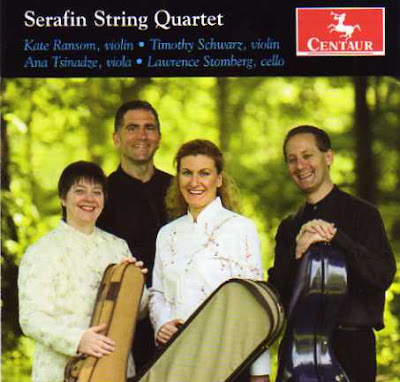[Serafin String Quartet; Centaur 3050 (2010) (65:52)]
On September 16, 2010 AfriClassical posted: “William Grant Still's 'Danzas de Panama' on CD 'Serafin String Quartet' Centaur 3050 (2010).” The ensemble is comprised of Kate Ransom, violin; Timothy Schwarz, violin; Ana Tsinadze, viola; and Lawrence Stomberg, cello. We explained that William Grant Still was represented on the CD by his composition Danzas de Panama, and we listed the four movements: 1.Tamborito, 2. Mejorana y Socavón, 3. Punto, 4. Cumbia y Congo.
The liner notes open with a section entitled: “Quartet American Style – Postcards from the American Musical Past.” It tells us: “William Grant Still's musical persona amalgamated two traditions – he was determined to devote his talents to the purpose of validating African-inspired music as part of the American cultural mainstream.” The composer was born in Woodville, Mississippi. The notes relate that Still's father died when the child was only a few months old, and that his mother then took him to Little Rock, Arkansas to live.
Renée Silberman writes: “Influences, circumstances and opportunities coupled with a mind receptive to the breadth of musical experience enabled Still to shape a sophisticated individualistic voice. He fused formal academic training with a command of contemporary popular music, 'the blues' in particular. Combined, they gave him the tools for developing his very personal 'racial form of expression.' The language that evolved from Still's quest for artistic self-identification was a means to the larger end of integrating African American idioms into operatic and symphonic compositions. Still never failed to acknowledge the importance of his contact with composers George W. Chadwick and the daring modernist Edgar Varèse; he was well aware, nonetheless, of his own power of innovative composition.
“By 1948, the year Danzas de Panama appeared, Still was legendary as 'the Dean of American Negro Composers,' and at the peak of his career – renowned for fashioning folk idioms into high art forms, inspired largely, though not exclusively, by Negro sources.
“Danzas de Panama demonstrates Still's interest in Caribbean color, embracing African, Spanish and Indian elements. He borrowed melodies gathered by the violinist Elisabeth Waldo and created a work suited either for quartet or string orchestra. Tamborito derives from musical influences African slaves brought to the region. It is joyous and light, with percussive touches and rhythmic insistence shaping its sense of forward momentum. Mejorana y Socavón is a gently-constructed Spanish-Indian style, rather free-form movement conveying sound effects of folk guitars, mejoraneras, and three string violin, the Rabel. Punto, also summons up Latin imagery in its references to two traditional dances, the Zapateo or shoe-tapping portion and the Paseo or Promenade. In the final dance, Cumbia y Congo, Still abandoned himself to the spirit of the African slaves, who themselves found ecstatic release in this most sensuous dance. Traditionally, women danced in the steets with candles held high above their heads, while the men swirled around them. Infectious energy drives the work to its vibrant, vigorous conclusion.”
The works which follow on the recording are Antonín Dvořák's American String Quartet, Op. 96 (25:59); Samuel Barber's String Quartet in B Minor, Op. 11 (18:18); and George Gershwin's Lullaby for String Quartet (7:22). The three compositions combine with Danzas de Panama to form a rewardingly coherent program which is true to the promise of the introductory subtitle, “Postcards from the American Musical Past.” The CD is available at http://www.centaurrecords.com [William Grant Still (1895-1978) is profiled at AfriClassical.com, where a complete Works List by Prof. Dominique-René de Lerma is found.]





No comments:
Post a Comment